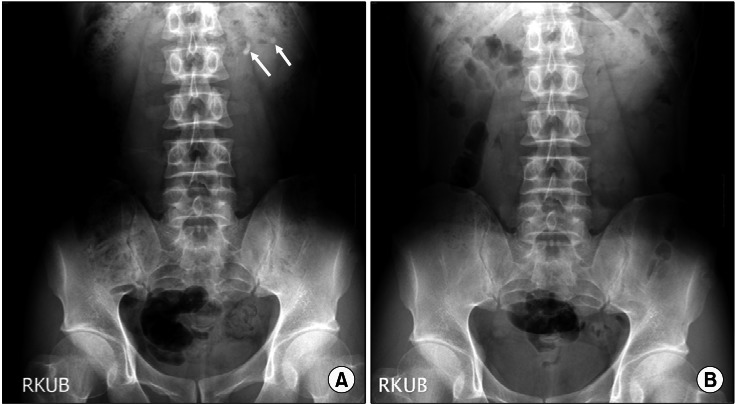Korean J Urol.
2013 Jun;54(6):377-382.
Effectiveness of Flexible Ureteroscopic Stone Removal for Treating Ureteral and Ipsilateral Renal Stones: A Single-Center Experience
- Affiliations
-
- 1Department of Urology, Chung-Ang University College of Medicine, Seoul, Korea. caucih@cau.ac.kr
Abstract
- PURPOSE
The aim of this study was to evaluate the effectiveness of simultaneous flexible ureteroscopic removal of stones (URS) for ureteral and ipsilateral renal stones and to analyze the predictive factors for renal stone-free status.
MATERIALS AND METHODS
We retrospectively reviewed the records of patients who underwent simultaneous flexible URS of ureteral and ipsilateral renal stones from January 2010 to May 2012. All operations used a flexible ureteroscope. We identified 74 cases of retrograde intrarenal surgery and 74 ureteral stones (74 patients). Stone-free status was respectively defined as no visible stones and clinically insignificant residual stones <3 mm on a postoperative image study. Predictive factors for stone-free status were evaluated.
RESULTS
The immediate postoperative renal stone-free rate was 70%, which increased to 83% at 1 month after surgery. The immediate postoperative ureteral stone-free rate was 100%. Among all renal stones, 15 (20.3%) were separately located in the renal pelvis, 11 (14.8%) in the upper calyx, 15 (20.3%) in the mid calyx, and 33 (44.6%) in the lower calyx. The mean cumulative stone burden was 92.22+/-105.75 mm2. In a multivariate analysis, cumulative stone burden <100 mm2 was a significant predictive factor for postoperative renal stone-free status after 1 month (p<0.01).
CONCLUSIONS
Flexible URS can be considered simultaneously for both ureteral and renal stones in selected patients. Flexible URS is a favorable option that promises high stone-free status without significant complications for patients with a stone burden <100 mm2.
Keyword
MeSH Terms
Figure
Reference
-
1. Turk C, Knoll T, Petrik A, Sarica K, Straub M, Seitz C. Guidelines on urolithiasis. 2012 update [Internet]. Arnhem: European Association of Urology;cited 2013 Jan 10. Available from: http://www.uroweb.org/gls/pdf/20_Urolithiasis_LR%20March%2013%202012.pdf.2. Prabhakar M. Retrograde ureteroscopic intrarenal surgery for large (1.6-3.5 cm) upper ureteric/renal calculus. Indian J Urol. 2010; 26:46–49. PMID: 20535284.
Article3. Bozkurt OF, Resorlu B, Yildiz Y, Can CE, Unsal A. Retrograde intrarenal surgery versus percutaneous nephrolithotomy in the management of lower-pole renal stones with a diameter of 15 to 20 mm. J Endourol. 2011; 25:1131–1135. PMID: 21657824.4. Breda A, Ogunyemi O, Leppert JT, Lam JS, Schulam PG. Flexible ureteroscopy and laser lithotripsy for single intrarenal stones 2 cm or greater-is this the new frontier? J Urol. 2008; 179:981–984. PMID: 18207179.
Article5. Kanao K, Nakashima J, Nakagawa K, Asakura H, Miyajima A, Oya M, et al. Preoperative nomograms for predicting stone-free rate after extracorporeal shock wave lithotripsy. J Urol. 2006; 176(4 Pt 1):1453–1456. PMID: 16952658.
Article6. Abe T, Akakura K, Kawaguchi M, Ueda T, Ichikawa T, Ito H, et al. Outcomes of shockwave lithotripsy for upper urinary-tract stones: a large-scale study at a single institution. J Endourol. 2005; 19:768–773. PMID: 16190825.
Article7. Abdel-Khalek M, Sheir KZ, Mokhtar AA, Eraky I, Kenawy M, Bazeed M. Prediction of success rate after extracorporeal shock-wave lithotripsy of renal stones: a multivariate analysis model. Scand J Urol Nephrol. 2004; 38:161–167. PMID: 15204407.8. Lim SH, Jeong BC, Seo SI, Jeon SS, Han DH. Treatment outcomes of retrograde intrarenal surgery for renal stones and predictive factors of stone-free. Korean J Urol. 2010; 51:777–782. PMID: 21165199.
Article9. Sung YM, Choo SW, Jeon SS, Shin SW, Park KB, Do YS. The "mini-perc" technique of percutaneous nephrolithotomy with a 14-Fr peel-away sheath: 3-year results in 72 patients. Korean J Radiol. 2006; 7:50–56. PMID: 16549956.
Article10. Chaussy C, Schuller J, Schmiedt E, Brandl H, Jocham D, Liedl B. Extracorporeal shock-wave lithotripsy (ESWL) for treatment of urolithiasis. Urology. 1984; 23(5 Spec No):59–66. PMID: 6719681.
Article11. Ghalayini IF, Al-Ghazo MA, Khader YS. Evaluation of emergency extracorporeal shock wave lithotripsy for obstructing ureteral stones. Int Braz J Urol. 2008; 34:433–440. PMID: 18778494.
Article12. Galvin DJ, Pearle MS. The contemporary management of renal and ureteric calculi. BJU Int. 2006; 98:1283–1288. PMID: 17125486.
Article13. Preminger GM, Tiselius HG, Assimos DG, Alken P, Buck AC, Gallucci M, et al. 2007 Guideline for the management of ureteral calculi. Eur Urol. 2007; 52:1610–1631. PMID: 18074433.
Article14. Cohen J, Cohen S, Grasso M. Ureteropyeloscopic treatment of large, complex intrarenal and proximal ureteral calculi. BJU Int. 2013; 111(3 Pt B):E127–E131. PMID: 22757752.
Article15. Takazawa R, Kitayama S, Tsujii T. Single-session ureteroscopy with holmium laser lithotripsy for multiple stones. Int J Urol. 2012; 19:1118–1121. PMID: 22853010.
Article16. Breda A, Ogunyemi O, Leppert JT, Schulam PG. Flexible ureteroscopy and laser lithotripsy for multiple unilateral intrarenal stones. Eur Urol. 2009; 55:1190–1196. PMID: 18571315.
Article17. Akman T, Binbay M, Ozgor F, Ugurlu M, Tekinarslan E, Kezer C, et al. Comparison of percutaneous nephrolithotomy and retrograde flexible nephrolithotripsy for the management of 2-4 cm stones: a matched-pair analysis. BJU Int. 2012; 109:1384–1389. PMID: 22093679.18. El-Anany FG, Hammouda HM, Maghraby HA, Elakkad MA. Retrograde ureteropyeloscopic holmium laser lithotripsy for large renal calculi. BJU Int. 2001; 88:850–853. PMID: 11851601.
Article19. Resorlu B, Unsal A, Gulec H, Oztuna D. A new scoring system for predicting stone-free rate after retrograde intrarenal surgery: the "resorlu-unsal stone score". Urology. 2012; 80:512–518. PMID: 22840867.
Article20. Takazawa R, Kitayama S, Tsujii T. Successful outcome of flexible ureteroscopy with holmium laser lithotripsy for renal stones 2 cm or greater. Int J Urol. 2012; 19:264–267. PMID: 22145599.21. Ito H, Kawahara T, Terao H, Ogawa T, Yao M, Kubota Y, et al. The most reliable preoperative assessment of renal stone burden as a predictor of stone-free status after flexible ureteroscopy with holmium laser lithotripsy: a single-center experience. Urology. 2012; 80:524–528. PMID: 22658621.
Article
- Full Text Links
- Actions
-
Cited
- CITED
-
- Close
- Share
- Similar articles
-
- Experience of Ureteroscopic Removal of Ureteral Stone in 35 Cases
- Clinical Experience with Ureteroscopic Management of Ureteral Calculi Including Electrohydraulic Lithotripsy
- Experience of Ureteroscopic Removal of Stone
- Ureteroscopic Stone Removal: Efficacy, Safety and Skilled Experience of the Surgeon
- Ureteroscopic stone removal


